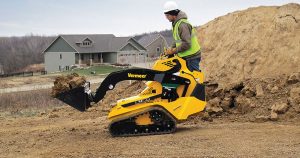A versatile, heavy-duty machine, the skid steer can be seen on construction sites and farms. It is also used for landscape projects and landscaping. A skid steer’s weight is an important factor to design and operate. A skid steer’s weight is crucial, because it has an impact on various performance aspects, such as safety and functionality. The significance of the skid steer’s weight will be explored in this article. Read more now on Boom & Bucket’s guide on skid steer weight.

Understanding Skid Steer Weight
Skid steer weight is defined as the combined mass of all the parts and components on the skid steer, including the frame. There are a variety of weights and sizes for skid steers. Smaller models weigh less than 1,000 pounds, while more powerful, larger machines can exceed 10,000 pounds. A skid steer’s weight is classified in two major categories, compact and large.
Compact Compact-Skid Steers: Compact Compact-Skid Steers are lighter, smaller models which can be easily maneuvered in narrow spaces. These machines typically range in weight from 2,000 to 5,500 pounds. Their lower weight makes them ideal for projects like residential and commercial construction where they are needed to cause minimal disruption of the soil.
Large-Sized skid steers: Large-sized (full-sized) skid-steers are heavier and larger, weighing between 5,000-10,000 pounds. The larger and heavier machines, capable of lifting more weight, are ideal for material handling, heavy construction and earthmoving.
The Effect of Skid Steer Weigh
Traction and Stability:The weight of the skid-steer plays a key role in stability. Heavy machines tend to be more stable. This applies especially when they are used for lifting large loads, or with attachments such buckets or forks. It is important to add weight in order to prevent the machine from tipping over and provide a safe working environment.
Grounded Pressure: ground pressure is an important factor to consider when calculating the weight of skid steers. Less heavy machines apply less force to the ground. This makes them perfect for landscaping and turf work, where protection of the soil is important. Conversely heavier skid steers will cause more disturbance to the ground, and this can be problematic when working on sensitive surfaces.
Skid Steer Lifting CapacityThe weight of the machine directly influences its lift capacity. A heavier machine can lift more weight due to its increased stability. Consider this factor when choosing the right skid steer to perform specific tasks like unloading or loading heavy material, and handling large attachments.
Mobility: The compact skid steers have a high level of maneuverability when in restricted spaces. Because of their lighter weight, they can navigate around tight corners and turn with greater ease.
Transportation and trailering : Also, the weight of a skid steer influences logistics. The weight of the machine can affect how much it costs to move equipment.
Fuel efficiency: Skid steer weight affects fuel consumption. Because they use less energy, lighter machines tend to consume less gasoline. However, smaller models may have a lower lifting capacity than larger ones.
How To Choose The Correct Weight for Your Skid Steer
To choose the correct skid-steer weight, consider the following factors: the scope of your project, the location conditions, as well as budget. Here are a few tips to help you select the best skid-steer weight.
Assess job requirements: Consider what the main functions of the skidsteer are. It may be best to use a compact model if the skidsteer will be primarily for indoor work or landscaping. In the case of heavy-duty excavation or construction, you may need a heavier, full-sized machine.
Site Evaluation: Evaluate the conditions of your job site. The lighter machines work best on delicate surfaces like grasses. Heavyer machines will need to be used for terrain that is rough and uneven.
Transportation: Take into consideration how to move the skid steer between the site and the shop. Be sure to have the proper trailer and towing vehicles to support the machine’s weight.
Long-Term Operating Costs: Take into account the cost of fuel, repairs, and maintenance. Skid steers with lighter weights can have lower running costs but they also may limit productivity.
Weight is one of the most important factors that affects a skid-steer’s performance, stability and versatility. Choosing the correct skid steering weight involves a thorough assessment of site conditions, job requirements and logistical factors. If you want to perform construction or material handling safely and efficiently, it is vital that you understand how the weight of your skid-steer machine impacts its operation.